The ‘Peach state’ of Georgia is a beautiful composition of farmlands, mountains, and coastal regions and is also the occasional or permanent home for 8 species out of the 19 species of owls in North America. Today we are going to explore the types of owls which you can find in Georgia and tell you what to look for when you are looking to spot them, as well as where they like to hide and a few fun facts that you can file away.
Types of Owls in Georgia
Let’s talk about the types of owls which you might encounter in Georgia. Scroll down more to read more details on each species such as coloration, size, habitat, and tips to find them!
- Barn Owl – Tyto alba
- Barred Owl – Strix varia
- Burrowing Owl – Athene cunicularia
- Eastern Screech Owl – Megascops asio
- Great Horned Owl – Bubo virginianus
- Northern Saw-Whet Owl – Aegolius acadicus
- Short-Eared Owl – Asio flammeus
- Snowy Owl – Bubo scandiacus
Barn Owl – Tyto alba
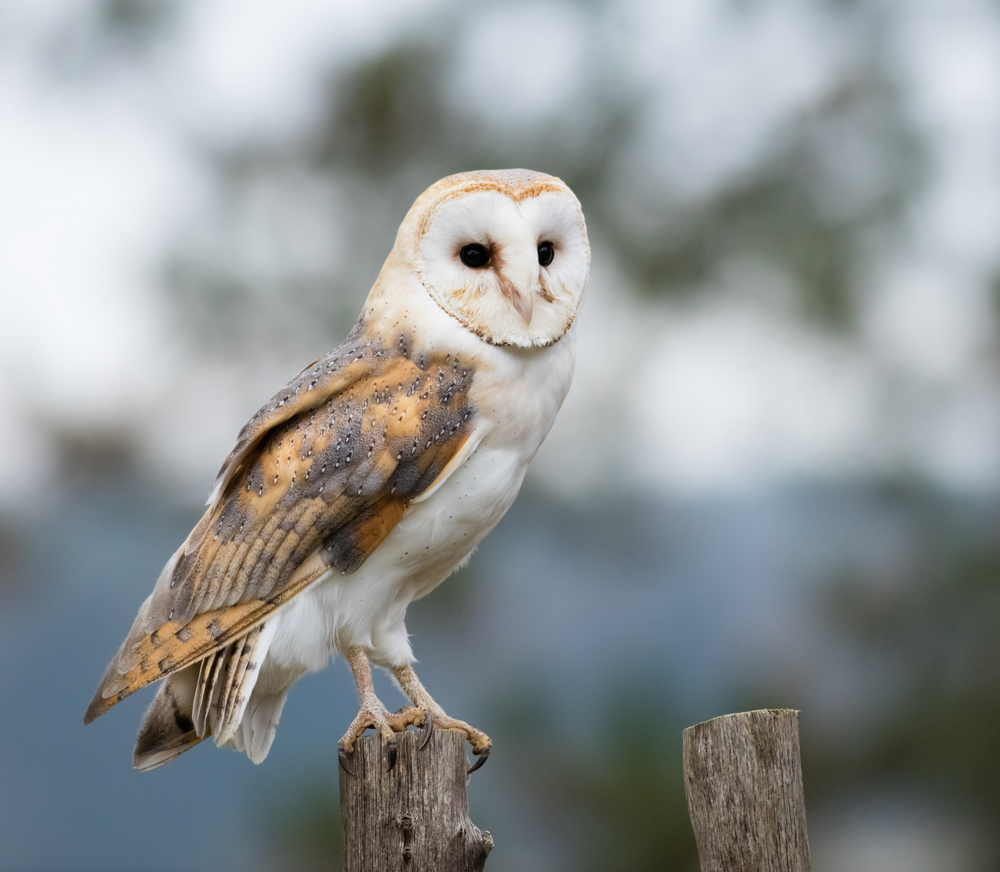
Coloration and Markings: Barn Owls are a sight to behold, with their backs, rounded wings, and short tails being a mix of grays and buff coloration while the underbelly, breast, and face are white. The face is a distinctive heart-shape and this owl has no ear tufts, giving the head a very smooth appearance. These owls have medium-length gray or pinkish-gray bills.
Size: These birds measure in at 12.6 – 15.8 inches in length and they have wingspans of 39.4 to 49.2 inches wide.
Habitat: Barn owls like to hunt in open areas, such as fields and marshes, though they tend to roost in tree-hollows, open areas of stone, or are the same suggests, in barns.
Diet: These birds eat small mammals and avians as well, dining on rabbits, mice, rodents, bats, and the occasional starling or mockingbird if they catch them out at dusk. As they hunt at night they prefer night creatures, so animals that hide away early such as squirrels are generally safe from the Barn Owl.
More about the Barn Owl
Barn Owls may be found all over the north and south of Georgia. Look for them around farms or close to marshes or rivers. Their shrieking call, once you have heard it, is quite distinctive and lets you know where to look but you are most likely to see them at dusk or dawn when they are leaving or returning from the hunt. They have a relatively short lifespan of about 4 years and due to their white under-plumage once you can hear them you can head in that direction and you have a good chance of spotting them. You can see them year-round in Georgia and occasionally even during the day, when their buff and gray colors stick out. During daytime the best place to look if you hear them is going to be in nearby barns or similar enclosures or a nearby dead tree.
Barred Owl – Strix varia

Coloration and Markings: Barred Owls are indeed barred in color, with a mix of browns and white on their backs, wings, and their medium-length rounded tails. Their bellies, by contrast, are a mix of vertical brown lines on white while at the upper portion of the breast the brown lines are horizontal. Facially, these owls have the appearance of a figure-eight pattern over the eyes and these owls have no ear tufts. These owls have medium-length yellow bills.
Size: These owls measure in at 16.9 – 19.7 inches in length and have wingspans of 39 to 43.3 inches wide.
Habitat: Barred Owls prefer evergreen and deciduous woods but have also been spotted in coniferous forests. When they are not hunting they are fond of roosting inside the cavities of trees.
Diet: These owls will eat a lot of things, including grouse, reptiles, rabbits, and any small mammals which they can catch.
More about the Barred Owl
Georgia Barred Owls are quite common residents of the Coastal Plains and have an impressive lifespan of 23 years. As seasoned predators, they tend to range out more often than most other owls so they don’t limit themselves to the forests where they like to roost. These owls are year-round residents of Georgia but the best time to look for them is from spring until the summer, when they are out looking for their mates. Their call is very distinctive and sounds like the owl is asking ‘who cooks for you?’, so if you are looking to spot the Barred Owl then this is what you’ll want to listen for. Many sources advise that imitating it’s call may also attract a Barred Owl’s attention, as they are rather territorial. There is an easier way to spot one, however, and that is to simply put out a nesting box. These owls are quite fond of boxes when they can find them, so this is an alternative to consider.
Burrowing Owl – Athene cunicularia
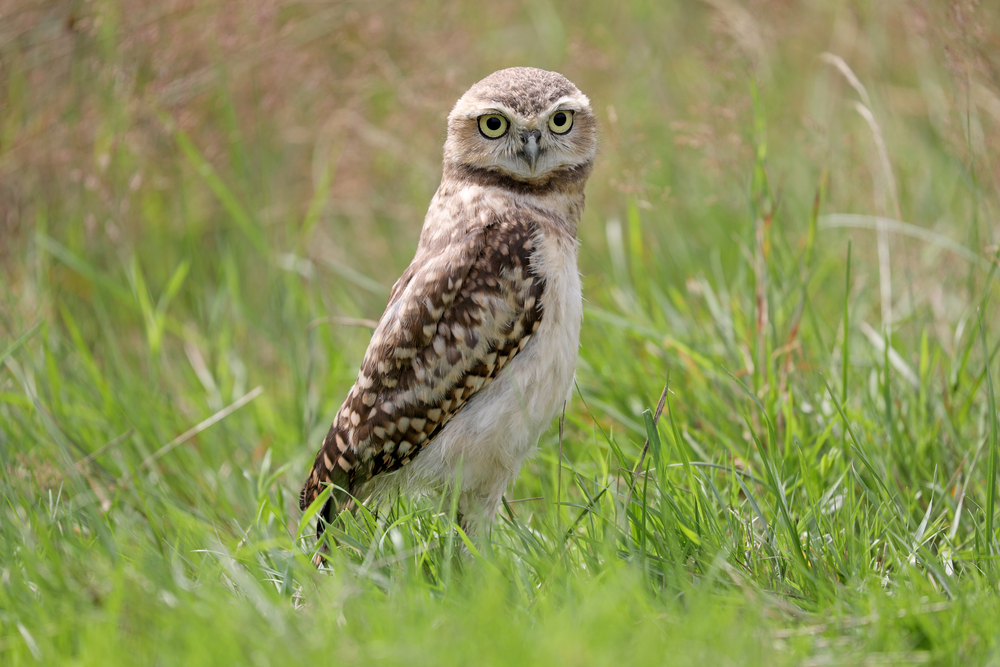
Coloration and Markings: Burrowing Owls have a mix of mottled brown as well as sandy-tan and white on their backs, wings, and their short tails. The belly and breast have a pattern of brown bars on white and this owl has a white throat and prominent white eyebrows. These owls have striking yellow eyes and juveniles are easy to spot, having less mottling, a yellowish-tan coloration on their underparts, and a telltale wing patch. These owls have medium length gray or yellow bills.
Size: These owls are tiny, measuring in at only 7.5 – 9.8 inches in length and with a wingspan of approximately 21.6 inches wide.
Habitat: These are prairie-owls, so to speak, preferring any large, open areas where the flora and fauna are sparse. As the name implies, these are ‘ground owls’, who often make their homes in discarded ground squirrel dens.
Diet: Burrowing owls eat small reptiles, mammals, and insects.
More about the Burrowing Owl
Found all over Georgia in areas that are open and sparsely vegetated, the Burrowing Owl is a curious little owl indeed. With a lifespan of approximately 6 – 8 years, Burrowing Owls are one of the easiest owls to spot in Georgia. This is because they are not quite so shy about hopping around on the ground or even standing still for long periods as they forage for snacks composed of delicious insects or lizards. Another reason they are easy to spot is that these are daytime owls. While most owls are nocturnal, Burrowing Owls prefer to do their hunting in the sunlight, generally close to some scrub or brush that they can duck into just in case a larger predator arrives. So the next time that you are in an open area, particularly one popular with ground squirrels, keep an eye out for this yellow-eyed gem of an owl. They truly are a delight to see.
Eastern Screech Owl – Megascops asio
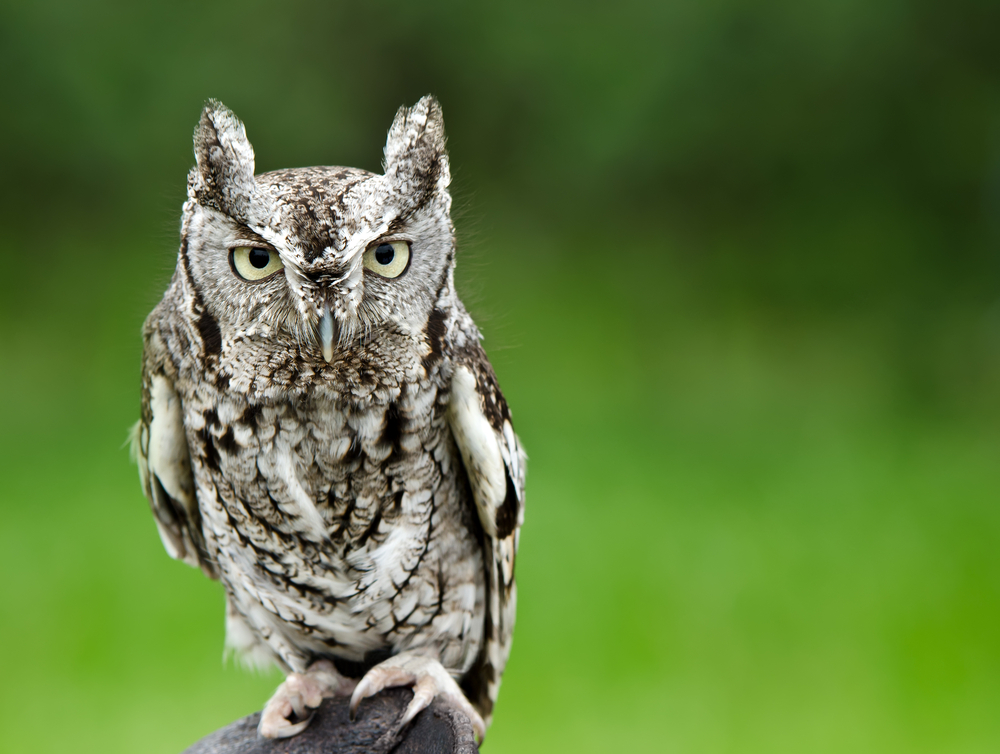
Coloration and Markings: The Eastern Screech Owl is another small owl that you’ll be delighted to see. Short and stout, their bodies are a collecting of spots and banding that are gray or even a rusty-red in color. They have rounded wings and small, square tails, and facially they have a v-shape above their eyes and prominent ear-tufts, which triangulate nicely between their serious yellow-eyed stares. These owls have thin, medium-length yellow bills.
Size: Roughly Robin-sized, these owls measure in at 6.3 – 9.8 inches and have a wingspan of 18.9 to 24 inches wide.
Habitat: These owls love the trees and blend right in with their complex plumage. You can find them in just about any type of woods, especially if there is water nearby.
Diet: Tadpoles crayfish, frogs, lizards, earthworms, and any small mammals that they can catch are what the Eastern Screech Owl will be having for dinner.
More about the Eastern Screech Owl
The most common owl in Georgia, the Eastern Screech Owl has a life expectancy of approximately 14 years and may be found in many places. While forests are primarily where you will spot them, nestled in tree-cavities during the day or by a chance glimpse at dusk or dawn, these owl sometimes hide in the suburbs as well. The Eastern Screech Owl loves a good nesting box and so you may attract one if you set up a box to receive it. If you are out on a nature hike in the woods, try looking for dead tree cavities and keep your eyes peeled for a little yellow color. The eyes of this bird are much easier to spot than the owl itself, due to the superior evolution of their plumage. They blend right in until you catch one staring at you.
Great Horned Owl – Bubo virginianus
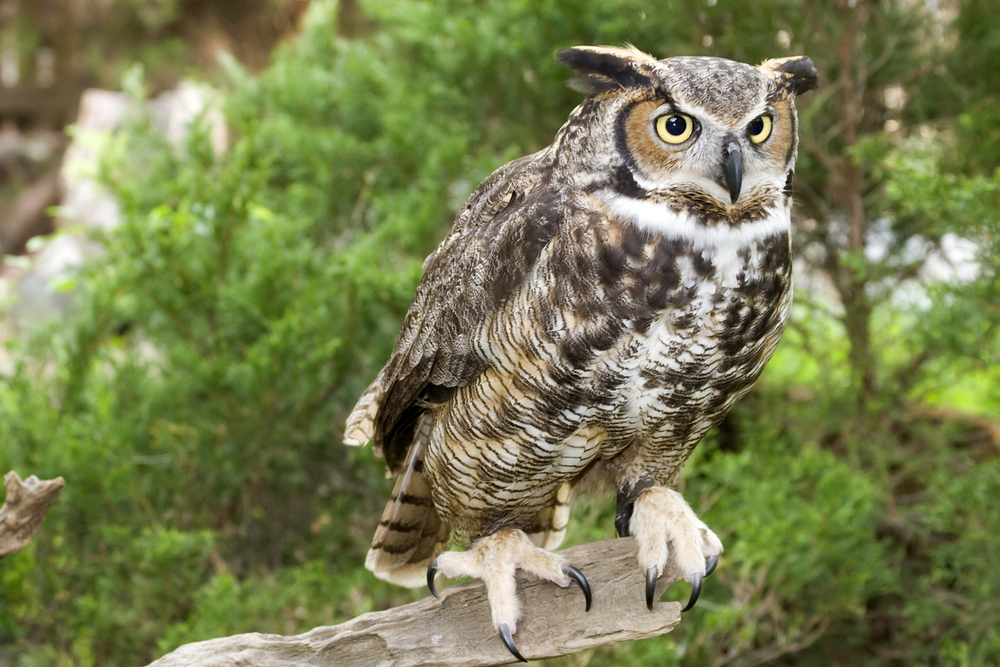
Coloration and Markings: Instantly recognizable, this is the owl you visualize from fairy tales. The Great Horned Owl has an overall gray coloration to its plumage, covering it’s back, rounded wings, medium-length tail, belly, and breast. Facially, it has a rounded-face with reddish coloration contained in a heart-shape, with a ‘v’ bisecting from the forehead just over the small, sharp bill. This owl has very prominent ear tufts that you can’t fail to miss. Occasionally you will see some red at the breast but they are generally an overall gray.
Size: Large owls, these birds measure in at 18.1 – 24.8 inches in length and have impressive wingspans of approximately 39.8 to 57.1 inches wide.
Habitat: These owls are expert predators and as such they have a wide range of environments. Preferring evergreen or deciduous woodlands with nearby clearings, they also range out into desert, tundra, or even suburban areas.
Diet: We weren’t kidding about the expert predator aspect. These owls can eat animals larger than themselves, even other predatory birds. When they aren’t hunting something larger, they snack on fare such as scorpions, mice, or whatever other smaller animals that they can catch.
More about the Great Horned Owl
The Great Horned Owl may be spotted just about anywhere in Georgia and not just at dusk or dawn. These bold predators sometimes hunt during the daylight and may even be spotted in the city. They have a lifespan of an impressive 28 years and if you see one in your area, consider putting up a nesting box. These long-lived owls are quite fond of them and you might just lure in a breeding pair as your new and welcome neighbors. They’ll definitely keep the mice out of your garden!
Northern Saw-Whet Owl – Aegolius acadicus
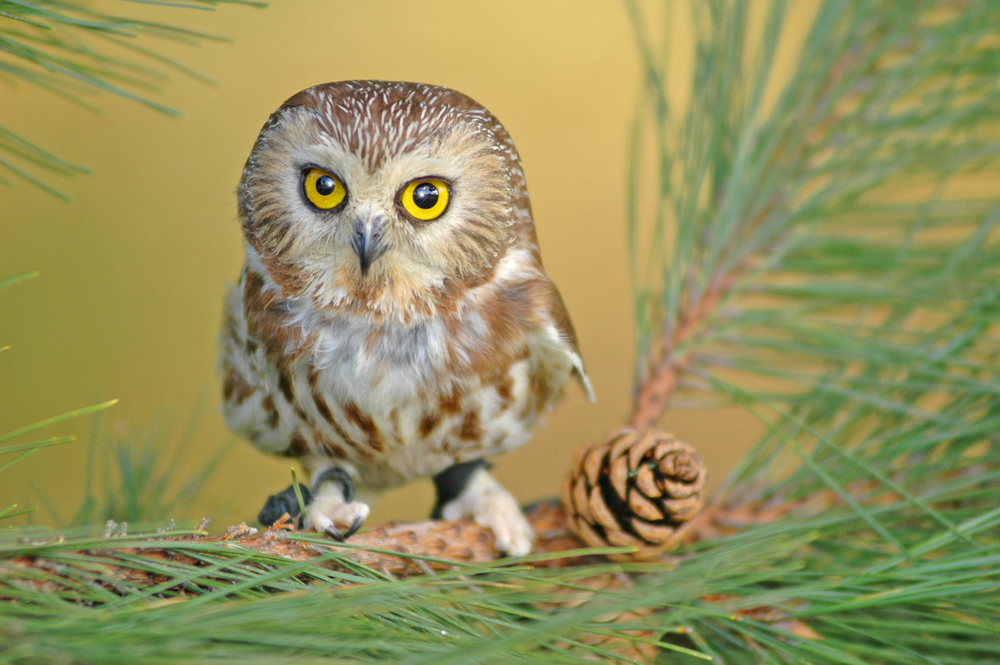
Coloration and Markings: Northern Saw-whet Owls are adorable, as their heads are quite large and it gives them an almost cartoonish appearance. Their backs and wings are brown, with a peppering of white, but their belly and breast are a more solid white laced with spaced brown streaking. Facially, they have rounded heads with no ear tufts and the ‘figure 8’ look of white and a thing outline of tan to make the ‘8’ which surrounds their bright yellow eyes. These owls have short, sharp black bills.
Size: These owls measure in at 7.1 – 8.3 inches in length and have wingspans of 16.5 to 18.9 inches wide.
Habitat: These birds spend their time mostly in forests of any type, though sometimes you will find them in more open areas as long as there is somewhere nearby to nest.
Diet: Saw-whet Owls eat insects, small birds, deer mice, and even squirrels!
More about the Northern Saw-Whet Owl
The Northern Whet-saw Owl may be found in Georgia forests but the best time to spot them is going to be in the winter, as this when they will be migrating in and looking for new homes. These small owls have a life expectancy of about 7 years and if you are out looking for them, listen for a call that sounds like ‘too too too’. The white in their brown feathers makes them easier to spot than many other woodland owls and they really are a treat to see. You can also keep an ear out for the local songbirds, which are well-aware when one of these owls is nearby and will begin ‘sounding the alarm’ until the Northern Saw-whet has left the area.
Short-Eared Owl – Asio flammeus
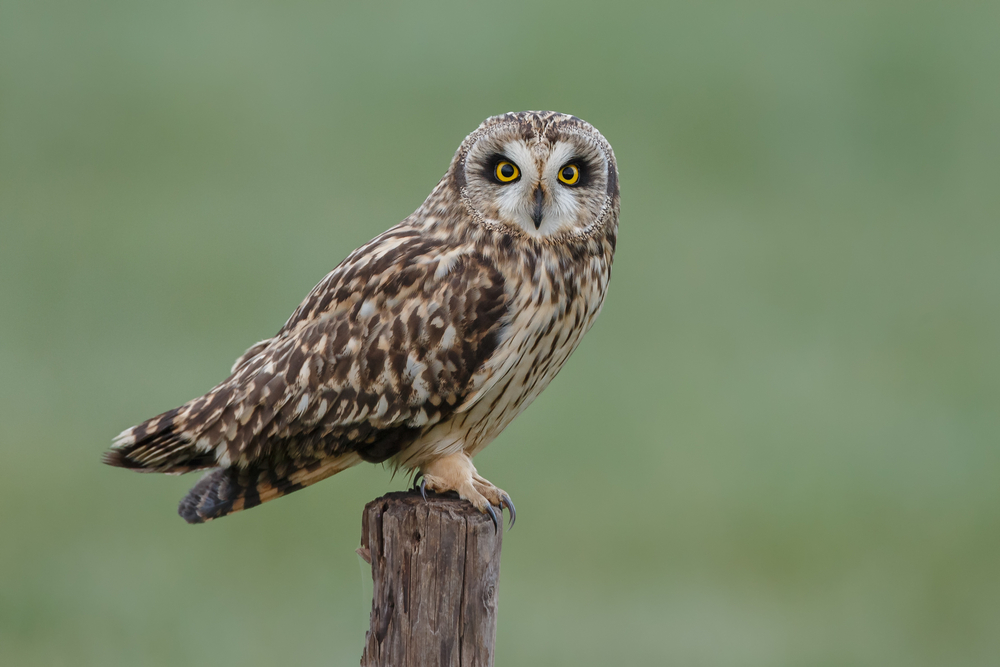
Coloration and Markings: Short-eared Owls have a brilliant mix of brown, buff, and white spotted plumage on their backs, their rounded wings, and short tails. The wings will typically have one white patch that you can look for as well and the underwing has a comma-shaped mark which you can look for by the bird’s wrist. Their belly and breast are colored differently and you should see a pale grayish or buff color with heavy brown streaking. Facially, these owls have yellow eyes, outlined in black, with white in the center bisected by the brown, tan, and white spotting down from the forehead. These owls have small black bills and their ear tufts are there, but very small and hard to see.
Size: These owls measure in at 13.4 – 16.9 inches in length and have wingspans of 33.5 to 40.5 inches wide.
Habitat: Short-eared Owls like to spend their time in fields, grasslands, and other open areas where thye like to hunt.
Diet: Juveniles will sometimes dine on insects but the typical Short-eared Owl diet consists of small mammals and the occasional bird.
More about the Short-Eared Owl
The Short-eared Owl is a ground-nesting bird which you can sometimes spot in open-areas across Georgia. They like to nest under low vegetation and can sometimes be spotted in small copses of trees near open areas or even simply hopping on the ground as they forage for snacks. They have a life expectancy of 4 to 12 years and as they are migratory the best time for spotting them is going to be in the winter. These owls are typically out hunting starting after dusk, hiding away during the day, but you can sometimes catch a lucky glimpse at dawn if the owl happens to be doing a little last-minute hunting before bedtime.
Snowy Owl – Bubo scandiacus

Coloration and Markings: Snowy Owls are quite rare and easy to recognize, due to their overall white plumage which is speckled with bits of brown and black. The whiter the bird, the more likely it is that you are seeing a male, as females tend to exhibit a denser concentration of the added colors while the males tend to lighten even more with age. These large owls have rounded wingtips and medium-length tails and you will also notice a striking set of yellow eyes set in a pure-white, rounded face, though you can see the peppered colors on the top of the head. These owls have small black bills.
Size: Snowies measure in at 20.5 – 27.9 inches in length and have wingspans of 49.6 to 57.1 inches wide.
Habitat: These owls are found in fields, airports, and especially near bodies of water, both freshwater and coastal.
Diet: Snowy Owls consume rodents voraciously and are especially fond of lemmings.
More about the Snowy Owl
We’ve included this owl on the list but if you see one then you’ve really gotten lucky. This is because the Snowy Owl has only been spotted in Georgia about 4 times in the last 70 years! These owls go where they like, so keep an eye out and you might behold the lucky 5th spotting. The beautiful Snowy Owl has a life expectancy of 10 years and apparently a wide distribution, as paintings of them have been found in caves in Europe! They do not limit themselves to night hunting, so they may be spotted at any time of the day, but remember that they only made this list due to 4 Georgia sightings. Should you be lucky number 5 we hope that you have a camera handy!
In Conclusion
We hope that you’ve enjoyed this little tour of owls in Georgia and that you have gleaned a fact or two that might help you to find one. Owls are tricky to spot due to their typical hunting hours but keep an eye and an ear out. A telltale call, a flash of yellow eyes, or even a chance look at the ground might be all that it takes to spot one of these stunning creatures. Until next time, happy birding!
